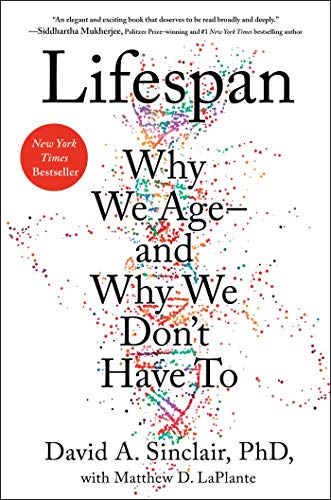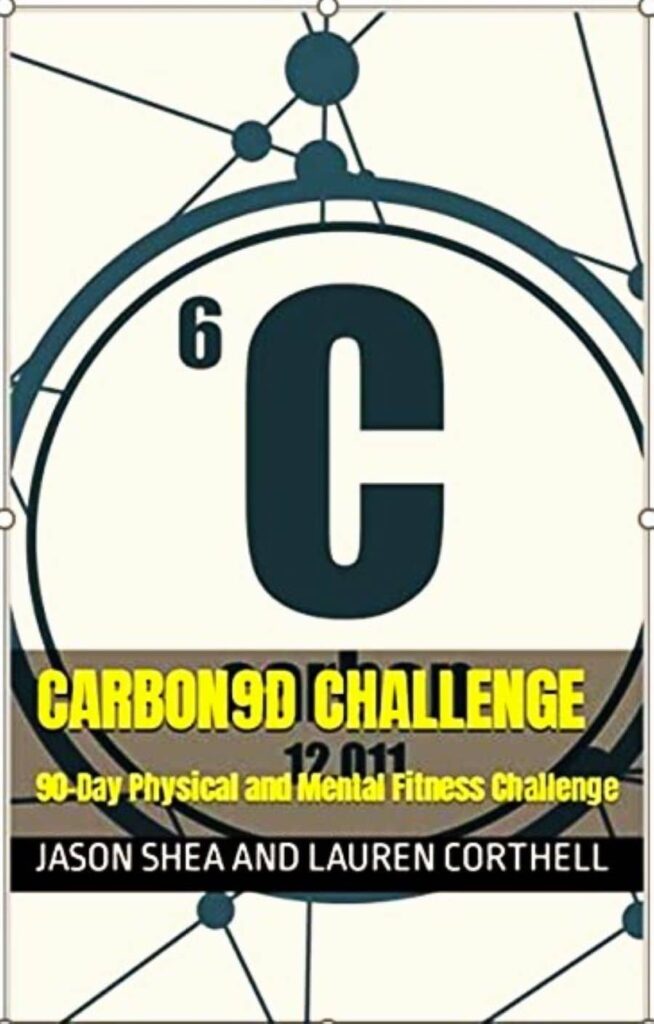By Jason Shea M.S., CSCS, PICP IV
What does longevity mean to you?
Being able to play with your grandkids well into/past your 80’s? Playing a round of golf, tennis, or other sports with minimal limitations? Hiking? Climbing? Cycling? Running? Winning a round or two (or three) of Jeopardy against your children and grandchildren? Smiling and pain free on a daily basis well into your retirement?
How about sub 10% bodyfat, able to perform 39 strict chin ups, and sail around the world? All at the age of 72! True story. Will talk about it later.
As you can see longevity can mean different things to different people. Let’s get started with some longevity trends.
Compiling data from macrotrends.net, here are the life expectancy trends per decade starting in 1951:
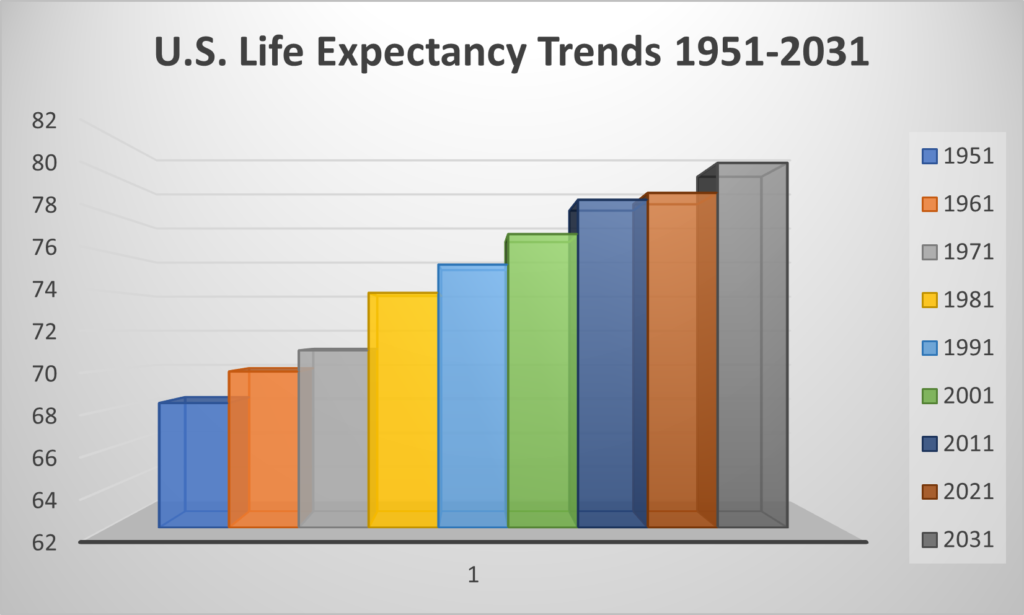
Great news.. our life expectancy has increased by nearly 15%! Where do we stand compared to the rest of the world? Below is we have a chart of the top 39 countries by life expectancy in 2021 (more data from Macrotrends.net). Notice the bottom right of the chart….the U.S. comes in at #39.
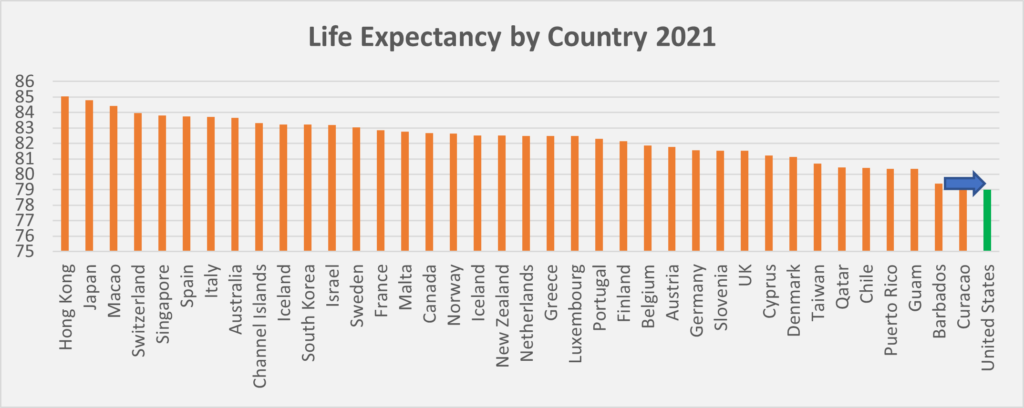
Lifespan vs Healthspan
Did you know that the average age for first occurrence of of Type 2 Diabetes and COPD are under the age of 55? First occurrence of Breast Cancer, Lung Cancer, Heart Disease, Stroke, and Alzheimer’s all have been found to happen in the early to mid-sixties?
According to this January 2020 Eureka Alert report, the American Heart Association has found that our (U.S.) current healthy life expectancy (healthspan = free from disease) is roughly 66 years of age. If we’ve done the math correctly, that means that roughly 16% of our expected lifespan (or 13 of our 79 years) may be wrought with illness, disease, and sickness?
What are some of the potential culprits? Stress. Probably. Lack of sleep. Most likely. Toxin exposure. Lack of exercise. Vitamin and mineral imbalances. All of these may play a role in deteriorating health. We can’t forget about this:
And maybe wash it down with some of this:
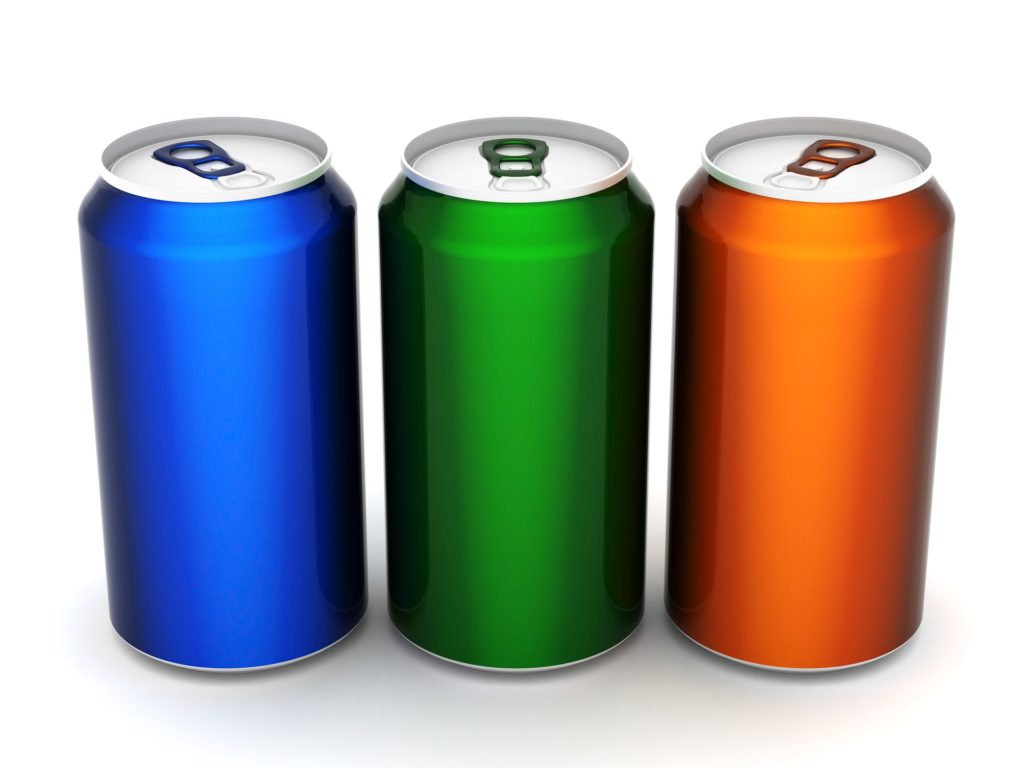
Unfortunately all of above mentioned can lead to obesity and associated diseases. Below are the obesity trends (CDC) from 1960-2008.
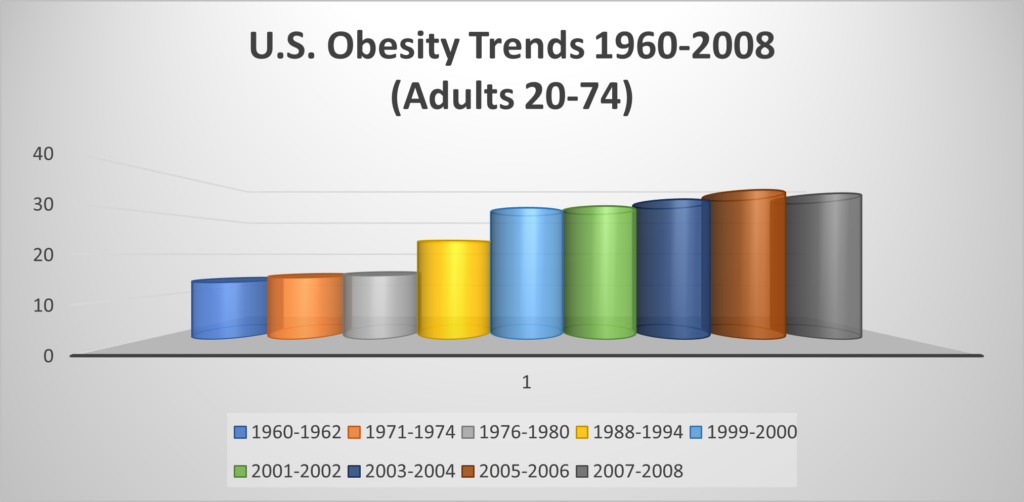
Here are the trends from 2009 to 2018.
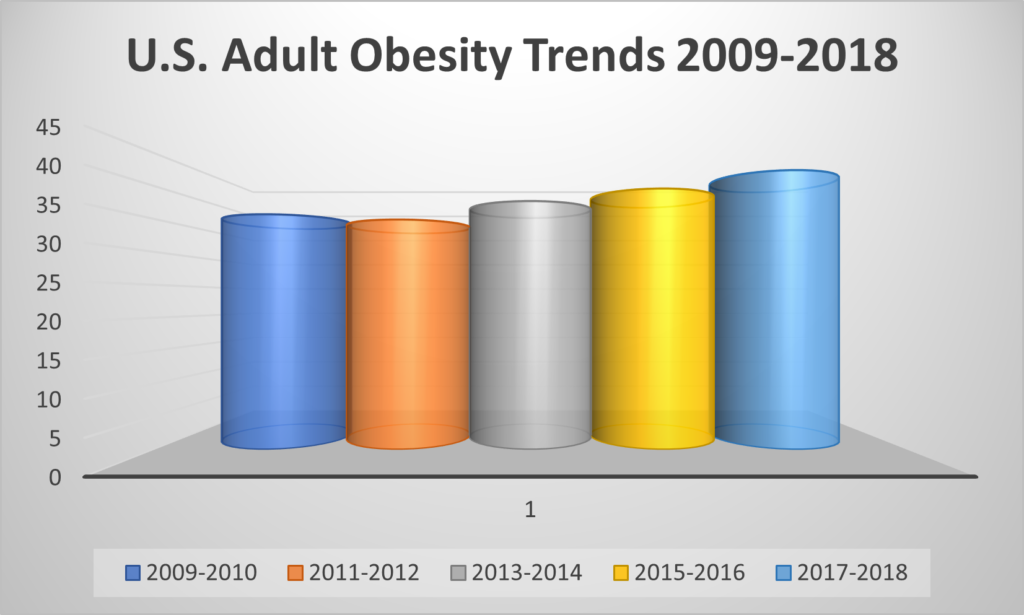
According to this CDC long term diabetes trends report and this 2020 CDC Diabetes report, the incidence of diabetes in the U.S. has increased significantly from just under 2% of the population in 1958 to nearly 12% of the population in 2020.
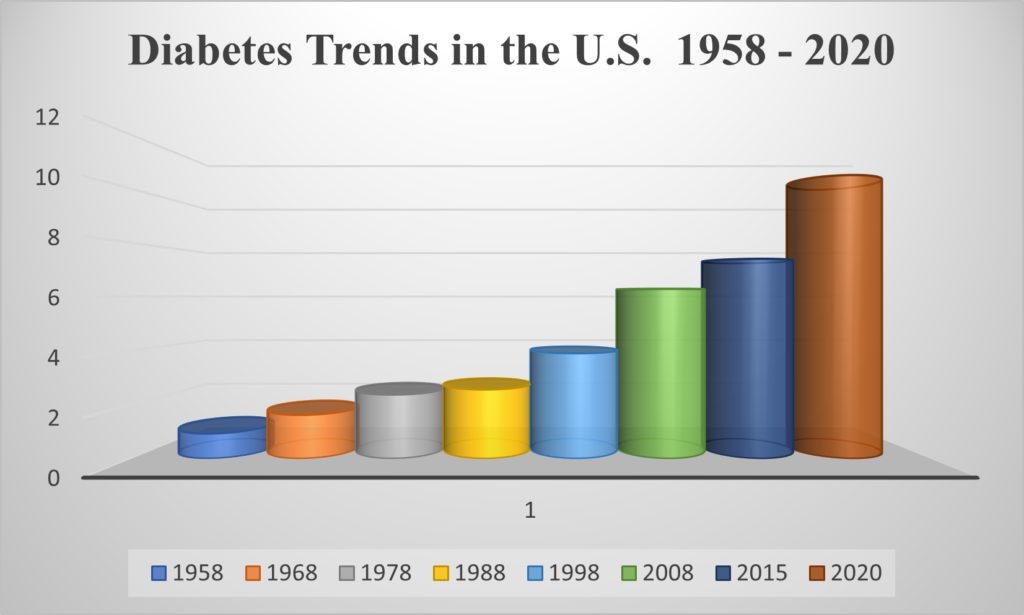
Okay…. so now what?
History of Longevity/Senescence Research
Senescence is part of the aging process in which cells no longer divide or grow. Below is a timeline of the highlights our interest in Senescence.





What doesn’t kill you makes you stronger
Have you ever heard of something called Hormesis? According to a 2017 paper in Nature, “
“Hormesis refers to adaptive responses of biological systems to moderate environmental or self-imposed challenges through which the system improves its functionality and/or tolerance to more severe challenges (11)”
In 1995, MIT scientist Leonard Guarente, published his research when he discovered a gene in single celled organisms that helped them live longer in response to stress (in this case lack of nutrients). The gene was called the SIR2 (Silent Information Regulator) gene (21). Since that discovery, other SIR genes have been linked to longevity, including more recently, the SIRT6 gene’s impact on DNA repair.

14 Longevity/Healthspan Tips, Tools, and Strategies
1. Sleep Check
How important is sleep? Here are a few things a good nights sleep has been associated with:
- Energy Conservation:
- “the ultimate (evolutionary) function of sleep is energy conservation through a state-dependent coupling of biological operations (51).”
- Brain Health:
- Glymphatic system waste clearance occurs while we sleep (42)
- Weight Management:
- Lack of sleep decreases satiety hormone leptin while increasing hunger hormone ghrelin. This combined with decreased insulin sensitivity may lead to weight and fat gain (56)
- Immune Health:
- “sleep affects several immune parameters (8)”
- •More Immune Health and Combatting Inflammation:
- “reciprocal connections between the central nervous system, sleep and the immune system has shown that sleep enhances immune defenses and that afferent signals from immune cells promote sleep (25)”
- Heart Health/Blood Pressure and Metabolic Syndrome:
- “Several studies have found that experimental sleep deprivation leads to increased blood pressure and even half a night of sleep loss has been reported to increase BP in subjects with hypertension or pre-hypertension (41)”
- Growth Hormone:
- “70% of Growth Hormone secretion can occur in first half of sleep (41)”
- Testosterone:
- “serum testosterone decreased by 0.49 ng/dL per year of age, 5.85 ng/dL per hour loss of sleep and 6.18 ng/dL per unit of body mass index (BMI) increase (44).”
- Cortisol:
- “sleep deprivation has been found to lead to elevations in afternoon and early nighttime cortisol levels (41)”
- Thyroid and TSH Hormone:
- changes in TSH and Thyrodi from sleep deprivation can lead to alterations in metabolism and body temperature (41)
- And much more…
Tips to restore sleep
A. Take a free assessment:
- STOP-BANG Sleep Questionnaire
- Berlin Sleep Questionnaire
- Resmed Free 3 Minute Sleep Apnea Questionnaire
B. Read Dr. Mathew Walker’s #1 bestselling book Why We Sleep
C. A Few Sleep Hacks
- Try not to eat within 3-4 hours of going to bed. According to Alzheimer’s expert Dr. Dale Bredesen (more later) the blood that is needed by the brain’s glymphatic system, is instead used by the digestive system to digest food.
- Try some Magnesium Glycinate before going to bed. A few great brands include:
- Poliquin Brand Magnesium Glycinate (elemental chelate)
- Pure Encapsulations Magnesium Glycinate
- Thorne Research Magnesium Bisglycinate Powder
- If you have digestive or heartburn issues, topical forms of magnesium may be a good substitute.
- If you are severely deficient in magnesium, a great product (not the best tasting, though) is ReMag. ReMag is a magnesium designed for absorption and restoring magnesium levels. Magnesium expert and author of The Magnesium Miracle, Dr. Carolyn Dean is the brain behind this great product. If you want to learn more about magnesium, be sure to pick up a copy of her book, The Magnesium Miracle.

- Try an accupressure mat before going to bed. ProsourceFit is a great option.
- Tart Cherry Juice can help with sleep.
- GABA or Glycine can help keep you asleep.
- Weighted Blanket. Our personal favorite is the Gravity Blanket. For more information, check out their store on Amazon.com here.
- Minimize bluelight/bluescreen before bed. Its been shown to suppress melatonin production.
- Monitor heart, breathing, brain waves and more while you sleep. A few products include:
- MuseS: Headband technology that monitors brain activity during the day or while you sleep.
- OuraRing measures HRV, body temp, light, deep, and REM sleep and more.
- Innovo 50F Plus Oximeter to measure your night time heart rate and blood oxygen saturation (SpO2) levels.
- Beddr Sleeptuner. This forehead sensor measures oxygen levels, heart rate, sleep positions, quality of breathing in sleep position and more.
- Turn down the heat, minimize electronics/WiFi, and darken your room as best you can.
- Reishi Mushroom Extract has been shown to help lower cortisol and improve sleep (Chu 2007).
2. Intermittent Fasting/Calorie restriction
While Dr. Guarente was discovering the SIR2 gene on the East Coast at MIT, Dr. Valter Longo was on the West Coast discovering that calorie restriction in yeast led to three times longer lifespans. He found that when calories were restricted, the body goes into maintenance mode, cleaning up old cells and recycling damaged proteins. This led to a healthier cellular environment (33).
Years earlier (about 70 yrs), researchers Clive McCay and Mary Crowell studied the impact calorie restriction had on growth, body size, and life span (37). Below:

Following suit, Roy Lee Walford published his research on mice and calorie restriction in 1979, nearly 13 years before the famed Biosphere 2 project. In that 1979 paper, Walford expressed “Mounting evidence indicates that underfeeding initiated later in life may also influence life span favorably. Old mice after lifelong restriction, or moderately aged mice (16.5 months) after 4.5 months of restriction, display “younger” immune systems than do age-matched, normally fed controls, as judged by response to mitogens, the mixed lymphocyte reaction, and other determinants (59).”
From 1980 to 1996, other papers showing the benefits of calorie restriction were beginning to surface in the scientific literature:

Back to Dr. Valter Longo and his research. In 2015, he found that fasting could trigger stem cell regeneration of the immune system. He found that fasting (55)
- Killed damaged cells in many organs and systems and replaced them with newly regenerated cells from activated stem cells.
- Shifted the body into an abdominal/visceral fat burning mode, which continued after returning to normal diet.
- Led to a 6mmHG decrease in subjects with high or moderately high blood pressure
- Led to a 20 mg/dL decrease in participants with high cholesterol
- Led to a 25 mg/dL decrease in patients with high serum triglycerides
In a 2017 paper by Longo and his research team, they found that fasting (34):
- Increased lifespan by 18 percent
- The stem cell regenerative process rejuvenated the immune system, liver, muscle, and brain.
- Levels of several types of stem cells increased.
- Performance in learning, remembering, and motor coordination all improved.
- Ate the same amount of calories yet lost more weight (primarily abdominal fat), without losing muscle. muscle mass
- Tumors were significantly reduced
- Skin disorders were cut in half
If you haven’t read his excellent, best-selling book, The Longevity Diet, we highly recommend it! Also be sure to check out his 5 day Fast Mimicking Diet Program: Prolon.
Other recommended books on Nutrition and Fasting include The Longevity Paradox and Lifespan: Why We Age-and Why We Don’t Have To.
3. Minimize Impacts of Stress on Body and Brain
From the article 12 Simple Stress Management Strategies To Do Today (2020): “Learning how to manage stress in life can be one of the most important things we can do for our health. Recent surveys have found that our stress levels are on the rise:
This 2019 survey found in increase in workplace stress, with nearly 2/3 of respondents reporting higher stress levels now versus 5 years ago. Nearly 50% of the parents in this American Psychological Association survey reported stress levels between “8-10” on a scale of 1-10 with 10 being the highest and 1 the lowest. That same APA survey found that the economy and work were a significant source of stress in 70% of respondents.
Did you know there are over 50,000 book results when we do a search for stress management on Amazon. In performing a google search for stress management we can find stress management books, stress management articles, stress management ppts, stress management pdfs, how to manage stress essays, stress management toys, apps, gadgets, and more. It might be safe to say that many of us are feeling stressed?
Stress can be like a tidal wave; overwhelming and engulfing even the strongest among us at times. According to the surveys above, the importance of stress management and the ability to deconstruct the causes of our stress is more important now than ever.”
Stress can not only affect our bodies, but also our brains and our ability to remember things and make critical decisions under duress.
Brain Health Tips

Dr. Dale Bredesen is one of the leading experts in the world on Alzheimer’s, brain health, and cognitive decline. In fact he wrote the book on it: The End of Alzheimer’s Program. This book is quite remarkable in that it goes into detail about how our nutrition, hormones, toxic exposures, exercise (or lack thereof), sleep deprivation, genetics, stress, and more.. all can play a role in the development of Alzheimer’s.
One of the gems from this book is his KetoFlex 12/3 program. Sound like a great product right? KetoFlex 12/3 is a method of intermittent fasting/timed eating. The “Keto” is representative of becoming fat-adapted and allowing your brain to run off of ketones for fuel. The “Flex” is representative of having the metabolic flexibility to switch back and forth between ketones and glucose for energy. The “12” represents a 12 hour fast from your last meal of the day to your first meal of the next day. And the “3″ represents not eating within 3 hours of going to bed to allow your brain’s glymphatic system to drain accumulated metabolites etc.
Along with his excellent book and renowned research, he also founded Apollo Health. On the Apollo Health Website they offer a free Cognitive Quotient Assessment called the CQ Assessment. If you are concerned about decreased memory or cognitive decline, feel free to take this free assessment. It is well worth it!
For an excellent resource on how exercise can impact the brain, check out Dr. Jennifer Heisz’s NeuroFit Lab at McMaster University. She has been leading groundbreaking research on how different forms of exercise can impact the brain differently. There are a lot of interviews, videos, and research papers to comb through on her lab page.
A few highly recommended books that delve into the topic of how stress can impact our brain and decision making include:
The Stress Effect by Henry Thompson
Brain Wash by Drs Austin and David Perlmutter
The Hour Between Dog and Wolf by John Coates
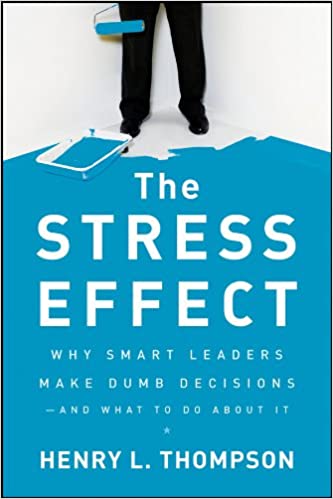
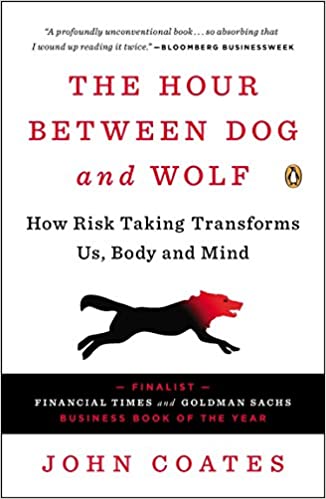
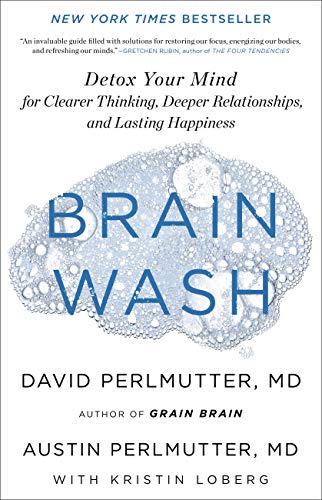
A few free online Stress Tests
The Mental Health America Stress Screener
4. Workout/Exercise
In a 2019 presentation to the European Society of Cardiology, Dr. Claudio Araujo shared his preliminary research findings on muscle power and all cause mortality in adults aged 41 to 85. They found that those adults with greater maximal muscle power had the best survival rates. In other words, those that had greater power lived longer (5).
A 2014 paper in Aging Cell found that “loss of muscle mass is indeed causally related to metabolic dysfunction in aging (Akasaki 2014).” The authors expressed that “interventions to preserve or enhance fast/ glycolytic muscle during aging-related muscle atrophy may delay the onset of metabolic dysfunction (2)”
More recently, researchers found resistance training had positive impacts on the brain. They found it boosted memory and cognitive functioning by decreasing neuroinflammation and increasing neuronal connections (7).
When is came to excessive long slow distance training, a group of researchers had 37 male endurance athletes continue their normal training or increase it by 40%/session for three weeks. Brain MRIs revealed the athletes who increased their volumes by 40%, had a significantly slower response in the lateral pre- frontal cortex. This is an important part of the brain when it comes to cognitive control, behavior, and information processing (6).
On the contrary, interval training in the form of HIIT (High Intensity Interval Training), can improve cognitive function and increase brain neuroplasticity. A 2019 study from the European Journal of Sport Science found that positive increases in BDNF (Brain-Derived Neurotrophic Factor) and cognition were associated with greater exercise intensities and higher lactate levels (4).
A separate paper from the 2020 Journal of Clinical Medicine, states that “current research indicates that lactate transport from astrocytes to neurons plays a crucial role for memory formation and could be a link between exercise and neuroplasticity (40). The same paper also points to a study by Van de Hall et al, that has “shown that lactate uptake in the brain increases from 8% at rest up to 20% during exercise (57).” Tip: The Rogue Echo bike may be one of the best tools for pushing interval intensities while driving up lactate levels. Stay tuned for future articles on lactate, brain functioning, and critical decision making under duress.
When it comes to hormonal responses from strength training, think of strength training as therapy for your hormones. A 2007 study had 20 male subjects who had never trained before, workout once, then tested baseline testosterone and cortisol levels. The subjects then worked out 3X per week for 4 weeks using a program consisting of 7 exercises. After 4 weeks they were tested again. The researchers found resting testosterone levels to be nearly 40% higher while both post training and resting cortisol levels were lower after only 4 weeks of training (3)”.
A great website for evaluating where you stand vs other trainees is StrengthLevel.com. You can check the standards they have accumulated for several exercises for age and weight categories for both male and female.
For a good bodyweight conditioning check, check out how you stack up against their burpee standards.
For some quick workouts for busy professionals check out his article. For much more on training and exercise technique, check this article out.
5. Get your Gut Healthy
- Did you know that probiotics have been linked to improved testosterone and thyroid hormone levels?
- How about probiotics and healthy skin and shiny hair?
- Wound healing?
- Muscle growth?
- Fending off obesity?
- Cardiometabolic disorders?
- Cancer?
- And last but not least…. Longevity?
A study from 2008 revealed that something called the gut-associated lymphoid tissue (GALT) represented nearly 70% of the entire immune system. The same study also found that roughly 80% of immunoglobulin A cells were also located there (Frati 2008)
3 of the best brands of Probiotics
Brand: BioGaia uses the patented L. reuteri DSM 17938 in their line of probiotic supplements. Their product line consists of:

- BioGaia Protectis, which contains 100 million live L. reuteri microorganisms, for general adult gut health.
- Biogaia Prodentis uses L. reuteri DSM 17938 in lozenge form to aid in restoring gum and oral health.
- BioGaia Protectis Baby Drops (with or without vitamin D) is recommended by pediatricians around the globe. Contains 100 million live L. reuteri as well.
- BioGaia Gastrus for gastrointestinal health contains the patented L. reuteri Gastrus which contains both L. reuteri DSM 17938 and L. reuteri ATCC PTA 6475.
- BioGaia Osfortis for bone health contains the patented L. reuteri ATCC PTA 6475 and vitamin D3.
For more info check out: BioGaia Probiotics – a world leading health care company
Brand: Innovia, by Italian company SOFAR, uses their trademark strain LP-DG (Lactobacillus paracasei CNCM I-1572) in improving intestinal bacteria composition, reducing inflammation, decreasing symptoms of bowel disorders.

SOFAR’s Eterolactis is the most prescribed probiotic by doctors in Italy and is regarded as one of the best probiotic supplement brands in the world. Innovia has two products, Liquid Fiber and Digestion, both in the form of micro-shots. You can get a 2 free samples from their site: Innovia Nectar: Probiotic Microshots
Brand: B. lactis HN019 is patented by HOWARU and found in brands including Poliquin Proflora Excellence.

HOWARU also contracts out to other supplement distributors allowing them to include their patented strains.
For a much more in-depth article that:
- breaks down the various studies on different strains and how they impact our health
- provides supplement buying tips and information on different brands and the strains they contain
- foods that contain probiotics and prebiotics
- and more
- be sure to read Workouts For Working People – The Ultimate Guide (2020) Part 3: Probiotics Benefits, Brands, And More.
6. Check for Food Sensitivities/Allergies
Did you know that thee are 8 types of foods that account for 90% of food allergies. These are: shellfish, soy, milk, tree nuts, fish, wheat, peanuts, and eggs.
Aside from these big 8 allergens, additives such as MSG, food coloring, high fructose corn syrup, and trans fats can cause some problems for some people.
A 2020 study from Endocrinology found that “over 100 genes are affected by Soybean Oil, including those that can lead to neurological conditions including autism, Alzheimer’s disease, anxiety, and depression (15). ” Another study, this one from 2015, found that “Soybean oil caused an increase of metabolites in the liver as well as upregulation of genes involved in obesity, diabetes, inflammation mitochondrial function, and cancer (14).
Chronic food sensitivity symptoms can range from depression, anxiety, fatigue, asthma, and joint pain while acute symptoms may come in the form of gas, constipation, bloating, diarrhea, and acid reflux.
Two options for testing for food sensitivity are an elimination diet or blood test. The elimination diet requires eliminating foods you feel you may be sensitive to and tracking how your body (and brain) respond. Here is a great guide/resource from the University of Wisconsin School of Medicine and Public Health.
For blood testing, finding a functional medicine doctor near you is a good place to start. The Institute for Functional Medicine offers a Find A Practitioner service.
7. Vitamin and Mineral Imbalances
Some of the more common vitamin and mineral deficiencies include magnesium, zinc, vitamin B12, and vitamin D.
To test for a zinc deficiency, a zinc status test has been shown to be a reliable at home method. Metagenics offers a high quality product.
Testing magnesium levels is not as easy. After you read The Magnesium Miracle, you will realize that most of us living in a westernized society may be walking around slightly deficient. A red blood cell (RBC) magnesium test is best. One of the issues with serum magnesium tests is they may not give you an accurate depiction of your magnesium levels in your tissue, bones, and other parts of the body.
1,25-hydroxyvitamin D measures the active form of vitamin D while 25-hydroxyvitamin D measures the inactive vitamin D in our body.
Like the food sensitivity blood testing, finding a functional medicine doctor near you is a good place to start.
8. Monitor your recovery
With any hard training, athletes and trainees need to recover. A few methods to measure and manage recovery from training include:
- Morning Grip Strength Test: In his excellent book, Science of Sports Training, sports scientist Thomas Kurz states “In overstrain, insufficient recovery, and in the initial phase of overtraining, the values of morning dynamometry go down (29).”
- Morning Heart Rate: Measure your heart rate first thing in the morning before you sit up or get out of bed to determine recovery/readiness to train. The higher your morning heart rate, the harder your body is working to replenish, restore, and detoxify. If your morning heart rate is on the lower end of the scale (<50 bpm), there is a good chance your body is recovered, well rested, and ready to train. For men, over 65 bpm may be a warning sign you need more recovery, while for women over 72 bpm may be a sign to take the day off of training.
- Vertical Jump Testing: A 2017 study out of Cal State Fullerton 17 subjects tested vertical jump height and power then found their 5RM in power cleans and 6RM in push press, back squat, RDL, and leg press.
The next day the subjects came back in, tested vertical, then worked out. They performed 4 sets of 5 reps in the hang clean, 4 sets of 6 repetitions in the push press with 2-minute rest between sets. Both exercises were performed at intensity level to ensure fatigue. Next, subjects did back squat, RDL, and Leg press for 4 sets each to failure. Immediately after the workout vertical jump was tested again.
The third day they came back in, tested vert, hit the same exact workout as the day before, then re-tested vert again.
The researchers found an 8% drop in vertical jump height for over 48 hours post workout. The vertical jump decrement had a significant correlation with a decrease in back squat performance.
According to the researchers “the ability of VJ height as a sensitive measure of readiness maybe explained by the bimodality of the stretch-shortening cycle (SSC) mechanism. Reductions in SSC performance happen immediately during exercise, recovering approximately 2 hours after exercise and demonstrate a secondary reduction 2 days after exercise when muscle damage is the greatest. Therefore, the current study demonstrates that measuring VJ height after a fatiguing workout and before a subsequent workout may be a beneficial tool for monitoring readiness to train (61).”
- Heart Rate Variability (HRV): (From Lifestyle Hacks and Workouts for Working People)
Your nervous system consists of the Parasympathetic and Sympathetic Nervous Systems. The Sympathetic increases your heart rate while the Parasympathetic slows it down. HRV is the variability between each heartbeat, which is under the control of the PNS and SNS. The healthier, fitter, and more resilient to stress you are, the higher the variability. The less resilient you are at dealing with stress and pressure, the lower the variability.
This method of monitoring resilience has been used for over 50 years, with some of the original measurements taken in astronauts to see how they dealt with the stresses of space travel. It has since been used by professional and Olympic athletes, military and special forces, SWAT, cardiologists, and more.
The Welltory free app is a good free option for beginners. The Oura Ring is another good option. Quite possibly the best at home tool is the Omega Wave. Used by a who’s who of professional teams and athletes, OmegaWave not only measures your heart rate via chest strap, but it also hooks up to the base of your thumb and your forehead to measure ECG, Omega (DC potential of the brain), neuromuscular, and reaction rate measurements. This info provides the user with what is called the Windows of Trainability. It also tells you your overall readiness to train, your CNS readiness, your cardiac readiness, and your energy supply readiness. This is an excellent tool, though it is not cheap. The unit runs $213.90, including the first month of the required $14.90/month subscription. For more on this excellent product check out Omegawave.
For more info and tips on recovery tools and methods stay tuned for our upcoming article series on the topic of recovery.
9. Practice Mindfulness/Meditation

10. Walk

10. Dance

11. Cold Water Exposure

12. Spend some time at the Beach/Ocean


13. What is your inner age/Lifespan?
In 2009, a group of MIT, Harvard, and Tufts genetics, aging and biometric data experts collaborated in an effort to optimize individual health and extend healthspans/longevity. They collect blood samples and analyze DNA, lifestyle, and nutrition habits and provide recommendations based on these metrics and more. Their company Insidetracker, offers multiple plans including: The Ultimate Plan, where they test 43 total biomarkers, provide DNA insights and more; The DNA Kit where they test 261 genetic markers that reveal your wellness traits and risks; and lastly, InnerAge 2.0. Here they determine your body’s real age from the inside using 14 biomarkers for females and 18 biomarkers for males. Click here to learn more about InnerAge 2.0.
Another company in the longevity and healthspan sector is Elysium Health. One of the founders is the MIT research scientist we mentioned earlier, Dr. Leonard Guarente. Elysium Health not only offers two longevity supplements with their Basis and Matter products, but they also offer Index, a biological age screening tool that calculates the rate at which your body has aged.
Online you can find a few free assessments where the goal is to provide some basic insight into lifespan and longevity potential. These include:
Blueprint Incomes Life Expectancy Calculator
and
The Bluezones 3 Minute Life Expectancy Test
14. Longevity Supplements
A few of the more promising longevity and healthspan supplements include:
NMN (Nicotinamide Mononucleotide)
A 2019 study stated that “this biomolecule has demonstrated numerous beneficial pharmacological activities in several preclinical disease models including myocardial and cerebral ischemia, neurodegenerative disorders like Alzheimer’s disease, and diabetes. The most recent discovery. it’s anti-ageing, life-span prolonging properties (45)”
Doublewood NMN, GenEX Formulas NMN Stabilized form, and Genius Eternal are highly rated brands.
Astaxanthin
A xanthophyll carotenoid, Astaxanthin is the most abundant carotenoid in marine organisms and is one of the most powerful natural compounds with very high antioxidant activity. Astaxanthin has been shown to positively impact Insulin and blood sugar, muscle growth, performance, recovery, oxidative stress and immune/nervous system health (52). Sports Research Astaxanthin is a our favorite Astaxanthin product.
Fisetin
In a 2018 research paper titled Fisetin is a senotherapeutic that extends health and lifespan, researchers tested the senolytic activity of resveratrol, fisetin, luteolin, rutin, PGCG, curcumin, pirfenidone, myricetin, apigenin, catechin, and quercetin. Fisetin, a coloring agent flavonoid commonly found in strawberries, apples, onions, and cucumbers, was found to have the greatest senotherapeutic activity (62). Life Extension Fisetin and HumanX Fisetin are the brands we like.
CoQ10
CoQ10 has been “associated with skeletal muscle performance during aging as evidenced by the fact that a high CoQ10H2/CoQ10 ratio (17)” . A 2015 study found that CoQ10 “confers health benefits in elderly people by preventing chronic oxidative stress associated with cardiovascular and neurodegenerative diseases (20)”. A 2014 study on “420 patients suffering from chronic heart failure demonstrated an improvement in symptoms and reduction in major cardiovascular events (39)”. Lastly, a 1009 study found that supplementing with Coq10 can lead to improvements in high blood pressure within 3 weeks (23). To help guide you through all the different CoQ10 products, check out supplement testing company Labdoor’s rating of the top 10 CoQ10 products.
Acetyl L Carnitine
A 2005 study found that Acetyl L Carnitine may play a critical role as modulator of cellular stress response in health and disease states (10). DoubleWood Acetyl L Carnitine and Designs for Health Carnitine Synergy are two great products.
Green Tea
Studies have found green tea has a positive effect on neuroprotection, autophagy, oxidative stress, and longevity (46). Dragon Herbs is a great site to find green tea and other Chinese Medicinal herbs and tonics.
NAC (N-Acetyl Cysteine)
A 2018 research found that NAC positively impacts the body’s production of the major antioxidant glutathione. NAC has potential as an effective agent in preventing the degenerative processes caused by aging (54). 1MD ImmunityMD is a good product that has NAC, Elderberry, Vitamin C and E, Zinc, and more.
PQQ
Has been shown to improve cellular energy metabolism, mitochondrial health, and upregulate antioxidant potential in skeletal muscle (24). Life Extension is a quality brand of PQQ.
Alpha Lipoic Acid
This potent antioxidant has been found to play a positive role in the aging process (43). Thorne Alpha Lipoic Acid and Life Extension Super R-Lipoic Acid (stabilized) and Doctors Best Stabilized R-Lipoic Acid are good brands/products.
Thymic Protein
In 2001, researchers found that Thymic protein may improve immune function and white blood cell production in subjects with immune dysfunction syndrome and chronic fatigue (50). We like Genicel’s ProBoost.
Collagen Protein
A 2019 study found that collagen protein can potentially increase health and strength of connective and passive tissues in the muscle–tendon system, which may aid in improvement of fast and reactive movements (28).
Other flavonoids including Quercetin and Apigenen, spices like cinnamon and curcumin, have also shown promise as longevity promoting agents.
Stay tuned for our upcoming articles on Recovery, Brain Health, and more. Also if you are a busy parent or working professionals, and you’d like to learn more about many of the topics touched on above, be sure to pick up a copy of Lifestyle Hacks and Workouts for Working People.
![Lifestyle Hacks and Workouts for Working People (Healthy Aging for Busy Parents and Professionals Book 4) by [Jason Shea M.S. CSCS]](https://m.media-amazon.com/images/I/41vdLV8jb3L.jpg)
Thanks for reading!
References
- Adam et al. Effectiveness of a combined dance and relaxation intervention on reducing anxiety and depression and improving quality of life among the cognitively impaired elderly. Sultan Qaboos Univ. Med. J. 16; e47–e53. 2016.
- Akasaki et al. Glycolytic fast-twitch muscle fiber restoration counters adverse age-related changes in body composition and metabolism. Aging Cell.13(1):Pp 80–91.2014.
- Andrade R, Marino M, Marin D, Camacho G, Caballero M, Marino M. Variations in urine excretion of steroid hormones after an acute session and after a 4-week programme of strength training. European Journal of Applied Physiology. 99(1); Pp 65-71. 2007.
- Antunes B, et al. Short-time high-intensity exercise increases peripheral BDNF in a physical fitness-dependent way in healthy men. European Journal of Sport Science. Pp 43-50. 2019.
- Araujo et al. Muscle power in upright row movement: predictor of all-cause mortality in individuals between 41 and 85 years of age – Preliminary results. ESC Preventive Cardiology (Formerly EuroPrevent) 2019.
- Blain et al. Neuro-computational impact of physical training overload on economic decision-making. Current Biology.29(19); Pp 3289-3297. 2019.
- Booth F, et al. Resistance-exercise training ameliorates LPS-induced cognitive impairment concurrent with molecular signaling changes in the rat dentate gyrus. Journal of Applied Physiology. 2019.
- Bosedovsky et al. The Sleep-Immune Crosstalk in Health and Disease. Physiological Reviews. 99(3); Pp 1325-1380. 2019
- Burzynska et al. White matter integrity declined over 6-months, but dance intervention improved integrity of the fornix of older adults. Frontiers in Aging Neuroscience. 10.3389. March 2017
- Calabrese et al. Acetylcarnitine and cellular stress response: roles in nutritional redox homeostasis and regulation of longevity genes. The Journal of Nutritional Biochemistry. 17(2); Pp 73-88. 2006.
- Calabrese, E.J., Mattson, M.P. How does hormesis impact biology, toxicology, and medicine?. Aging Mech Dis 3, Pp 13. 2017. https://doi.org/10.1038/s41514-017-0013-z
- Calle et al. Overweight, obesity, and mortality from cancer in a prospectively studies cohort of US adults. New England Journal of Medicine. 348(17); Pp 1625-1638. 2003.
- Chu et al (2007). Extract of Ganoderma lucidum potentiates pentobarbital-induced sleep via a GABAergic mechanism. Pharmacology Biochemistry and Behavior. 86(4); Pp 693-698. 2007. doi:10.1016/j.pbb.2007.02.015
- Deol P et al. Soybean oil is more obesogenic and diabetogenic than coconut oil and fructose in mouse: potential role for the liver. PLoS One. 10(7); e0132672. 2015.
- Deol P et al. Dysregulation of hypothalamic gene expression and the oxytocinergic system by soybean oil diets in male mice. Endocrinology. 161(2); Pii;bqz044. 2020.
- European Society of Cardiology. “Ability to lift weights quickly can mean a longer life: Not all weight lifting produces the same benefit.” ScienceDaily,. April 2019.
- Fischer et al. Coenzyme Q10 status as a determinant of muscular strength in two independent cohorts. PLoS ONE 11:e0167124. 2016.
- Frati et al. Allergy and the gastrointestinal system. Clinical and Experimental Immunology. 153(1); Pp 3-6. 2008.
- Garrett et al. Coastal proximity and mental health among urban adults in England: The moderating effect of household income. Health and Place. 59. 102200. 2019
- Gonzalez-Guardia et al. Effects of the Mediterranean diet supplemented with coenzyme q10 on metabolomic profiles in elderly men and women. J. Gerontol. A Biol. Sci. Med. Sci. 70; Pp 78–84. 2015
- Guarente et al. Mutation in the silencing gene SIR4 can delay aging n S. cerevisiae. Cell. 80. Pp 485-496. 1995.
- Haboush et al. Ballroom dance lessons for geriatric depression: an exploratory study. Arts Psychother. 33; Pp 89–97. 2006.
- Ho et al. Blood pressure lowering efficacy of coenzyme Q10 for primary hypertension. Cochrane Database Syst Rev. 4; CD007435. 2009
- Hwang and Willoughby. Mechanisms Behind Pyrroloquinoline Quinone Supplementation on Skeletal Muscle Mitochondrial Biogenesis: Possible Synergistic Effects with Exercise. J Am Coll Nutr. 1; Pp 1-11. 2018.
- Irwin M. Sleep and Inflammation: Partners in Sickness and in Health. Nature Reviews. Immunology. 19(11); Pp 702-715. 2019
- Keil et al. Being cool: how body temperature influences ageing and longevity. Biogerontology. 16(4); Pp 383–397. 2015.
- Kim and Kim. Mood after various brief exercise and sport modes: aerobics, hip hop dancing, ice skating, and body conditioning. Frontiers in Aging Neuroscience. 104(4); Pp 1265-1270. 2007.
- Kirmse et al. Prolonged Collagen Peptide Supplementation and Resistance Exercise Training Affects Body Composition in Recreationally Active Men. Nutrients. 11(5); Pp 1154. 2019.
- Kurz T. The Science of Sports Training. Stadion Publishing. 2016.
- Lazar et al. Meditation experience is associated with increased cortical thickness. Neuroreport. 16(17); Pp 1893-1897. 2005
- Lazar et al. Mindfulness practice leads to increase in regional brain gray matter density. Psychiatry Research. 191(1); Pp 36-43. 2011
- Lin et al. Effect of resveratrol and pterostilbene on aging and longevity.Biofactors. 44(1); Pp 69-82. 2018.
- Longo et al. Regulation of longevity and stress resistance by Sch9 in yeast. Science. 292(5515); Pp 288-290. 2001.
- Longo et al. Fasting regulates EGR1 and protects from glucose and dexamethasone-dependent sensitization to chemotherapy. PLoS Biology. 15(3); 2017.
- Lubkowska et al. Winter swimming as a building up body resistance factor inducing adaptive changes in the oxidative/antioxidant status. Scandinavian Journal of Clinical and Laboratory Investigations. 2013
- Mattson and Cabo. Effects of Intermittent Fasting on Health, Aging, and Disease. New England Journal of Medicine. 381(26); Pp 2541-2550. 2019.
- McCay C, Crowell M. The effect of retarded growth upon the length of life span and upon the ultimate body size. Nutrition. 5(3); Pp 155-171. 1935.
- McNeely et al. A comparison of dance interventions in people with Parkinson disease and older adults. Maturitas 81; Pp 10–16. 2015.
- Mortensen et al. The effect of coenzyme Q10 on morbidity and mortality in chronic heart failure: results from Q-SYMBIO: a randomized double-blind trial. JACC Heart Fail. 2; 641–649. 2014
- Muller et al. Lactate and BDNF: Key Mediators of Exercise Induced Neuroplasticity? Journal of Clinical Medicine. 9(4); 1136. 2020.
- Mullington et al. Cardiovascular, Inflammatory and Metabolic Consequences of Sleep Deprivation. Progress in Cardiovascular Disease.51(4); Pp 294-302. 2009.
- Nedergaard et al. Sleep Drives Metabolite Clearance from the Adult Brain. Science. 342(6156); Pp 373-377. 2013
- Nobakht-Haghighi et al. Regulation of aging and oxidative stress pathways in aged pancreatic islets using alpha-lipoic acid. Mol Cell Biochem. 449(1-2); Pp 267-276. 2018.
- Patel et al. Impaired sleep is associated with low testosterone in US adult males: results from the National Health and Nutrition Examination Survey. World Journal of Urology. 37(7); Pp 1449-1453. 2019
- Poddar et al. Nicotinamide Mononucleotide: Exploration of Diverse Therapeutic Applications of a Potential Molecule. Biomolecules. 9(1): 34. 2019.
- Prasanth M. A Review of the Role of Green Tea (Camellia sinensis) in Antiphotoaging, Stress Resistance, Neuroprotection, and Autophagy. Nutrients. 2019 Feb; 11(2): 474. 2019
- Rathore and Abraham. Implication of Asana, Pranayama and Meditation on Telomere Stability. Int J Yoga. 11(3): Pp 186–193. 2018.
- Rattan S. Hormesis in Aging. Ageing Res Rev. 7(1); Pp 63-78. 2008.
- Remondino P. Longevity and Climate. Kessinger Publishing. 1890.
- Rosenbaum et al. Improved Immune Activation Markers in Chronic Fatigue and Immune Dysfunction Syndrome (CFIDS) Patients Treated with Thymic Protein A. Journal of Nutritional and Environmental Medicine. 11(4); Pp 241-247. 2001.
- Schmidt et al. State-dependent metabolic partitioning and energy conservation: A theoretical framework for understanding the function of sleep. PLoS One. 12(10); e0185746. 2017.
- Sztretye et al. Astaxanthin: A Potential Mitochondrial-Targeted Antioxidant Treatment in Diseases and with Aging. Oxidative Medicine and Cellular Longevity. 3849692.2019.
- Tahkamo et al. Systematic review of light exposure impact on human circadian rhythm. Chronobiology International. 36(2); Pp 151-170. 2018.
- Tardiolo et al. Overview on the Effects of N-Acetylcysteine in Neurodegenerative Diseases. Molecules.23; Pp 3305. 2018.
- University of Southern California. Fasting Triggers Stem Cell Regeneration of Damaged, Old Immune System. ScienceDaily. June 2015.
- Van Cauter et al. Brief communication: Sleep curtailment in healthy young men is associated with decreased leptin levels, elevated ghrelin levels, and increased hunger and appetite. Annals of Internal Medicine. 141(11); Pp 846-850. 2004.
- van Hall, G. et al. Blood lactate is an important energy source for the human brain. J. Cereb. Blood Flow Metab. 29: Pp 1121–1129. 2009.
- Verghese et al. Leisure activities and the risk of dementia in the elderly. New England Journal of Medicine. 348; Pp 2508–2516. 2003
- Walford et al. Influence of controlled dietary restriction on immunologic function and aging. Fed Proc. 38(6); Pp 2007-2016. 1979/
- Wany Y et al. Discovery of piperlongumine as a potential novel lead for the development of senolytic agents. Aging (Albany NY). 8(11); Pp 2915-2926. 2016.
- Watkins C et al. Determination of Vertical Jump as a Measure of Neuromuscular Readiness and Fatigue. Journal of Strength and Conditioning Research. 31(12); Pp 3305-3310. 2017.
- Yousefzadeh M et al. Fisetin is a senotherapeutic that extends health and lifespan. EBioMedicine. 36: Pp 18–28. 2018.
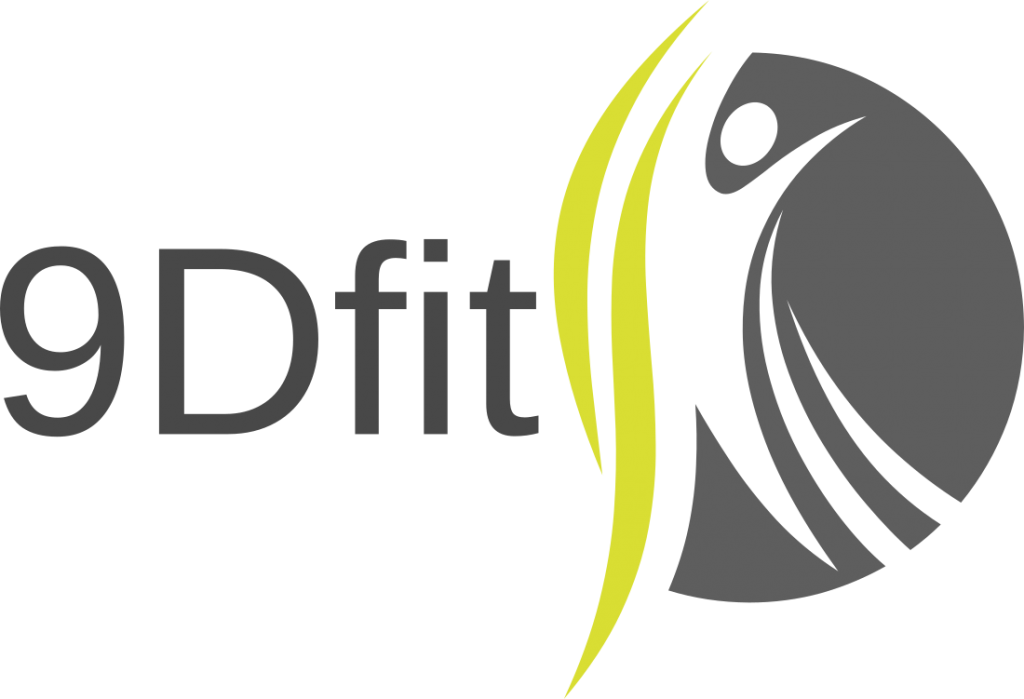


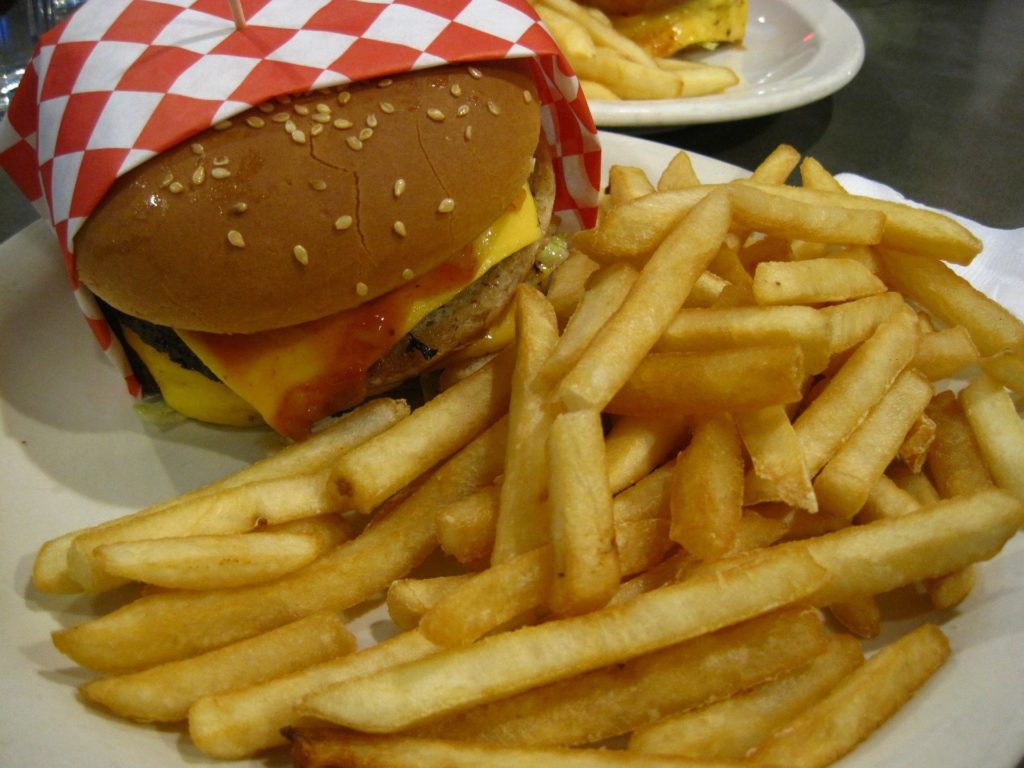

![Why We Sleep: Unlocking the Power of Sleep and Dreams by [Matthew Walker]](https://m.media-amazon.com/images/I/51WOq1TRGdL.jpg)


